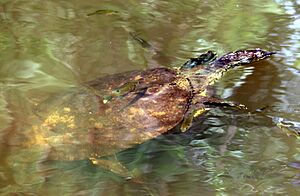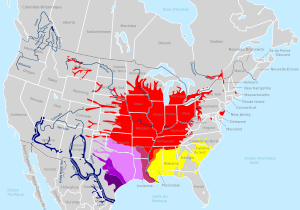Gulf Coast spiny softshell turtle facts for kids
Quick facts for kids Gulf Coast spiny softshell turtle |
|
|---|---|
 |
|
| Conservation status | |
| Scientific classification |
|
| Kingdom: | Animalia |
| Phylum: | Chordata |
| Class: | Reptilia |
| Order: | Testudines |
| Suborder: | Cryptodira |
| Family: | Trionychidae |
| Genus: | Apalone |
| Species: | |
| Subspecies: |
A. s. aspera
|
| Trinomial name | |
| Apalone spinifera aspera Agassiz, 1857
|
|
The Gulf Coast spiny softshell turtle is a unique type of turtle. It belongs to a family called Trionychidae, known for their soft, leathery shells. This special turtle lives only in the southeastern parts of the United States. Its scientific name is Apalone spinifera aspera.
Contents
Where Do They Live? (Geographic Range)
You can find Gulf Coast spiny softshell turtles along the Gulf of Mexico. They also live on the Atlantic coast, stretching from North Carolina all the way to Mississippi. These turtles prefer freshwater places like rivers and lakes in warmer, temperate areas.
What Do They Look Like? (Description)
The Gulf Coast spiny softshell turtle has some cool features! You can tell it apart from other spiny softshell turtles by the two or more black lines on the back edge of its shell. Its shell also has scattered ring-shaped spots, which might be harder to see on older female turtles. The edges of their shells are soft and have small spines.
Their heads and necks often have yellow and brown stripes and spots. They have a long nose that points upwards. Their bellies are usually whitish or yellow, and sometimes you can see their bones through the light-colored skin. Their bodies are olive or tan with dark speckles and a dark rim around the shell's edge.
- Males: Adult males have olive and yellow shells with black "eyespots." They also have thicker tails than females. Males are smaller, with shells measuring about 12.7 to 24 centimeters (5 to 9.5 inches) long.
- Females: Females are much larger, with shells from 24 to 48 centimeters (9.5 to 19 inches) long. Their shells are darker, and their tails are small, not extending past the shell's edge.
These turtles have webbed feet, which are perfect for swimming. Their toes end in claws. Big female turtles can live for more than 50 years!
Their Home Sweet Home (Habitat)
Gulf Coast spiny softshell turtles live in many different freshwater places. These include rivers, lakes, marshes, and even farm ponds. They also like the bays of larger lakes. They prefer open areas with not too many plants and a sandy or muddy bottom. For laying their eggs, they need sandy, raised spots close to the water.
Daily Life and Habits (Behavior)
These turtles are diurnal, which means they are active mostly during the day. They spend a lot of their time basking in the sun and looking for food. You might spot them sunning themselves on logs, river banks, or lake shores.
If something scares them, they quickly dive into the water. They then bury themselves in the sand or mud, leaving only their heads visible. Like many turtles, they can stay underwater for a long time. During the colder months, they become dormant. This means they spend their time underwater, buried in mud or sand, resting until it gets warmer.
If a spiny softshell turtle feels threatened, it will stretch out its long neck. It can snap quickly at an attacker, giving a painful bite!
What's on the Menu? (Diet)
Spiny softshell turtles are carnivores, meaning they eat meat. They mostly hunt for small creatures without backbones, called invertebrates. This includes things like crayfish and different kinds of aquatic insects. When they grow larger, they might also eat small fish sometimes.
They search for food under rocks, logs, and branches. They also look along the bottom of lakes, rivers, and streams, and among water plants. Sometimes, they hide in the mud or sand on the bottom. Then, they wait to ambush any prey that swims by!
Who Are Their Enemies? (Predators)
Spiny softshell turtles don't have many natural enemies. Large predatory fish, raccoons, herons, skunks, and red foxes might try to prey on them. Unfortunately, humans can also sometimes be a threat.
Raccoons, skunks, and foxes often dig up and destroy their nests. Young softshell turtles can be eaten by raccoons, herons, and big fish. Adult turtles are mostly safe from other animals. These turtles are shy. If they sense danger, they quickly dive and hide under mud and sand to stay safe.



